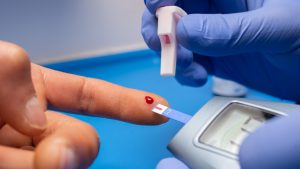When it comes to metabolic health, the relationship between body weight and blood sugar levels is widely studied. Scientific evidence has shown that weight loss can positively influence insulin sensitivity and help manage type 2 diabetes. But how significant is this impact? How much weight needs to be lost to see improvements? In this article, we will explore how weight reduction can support metabolic health and enhance overall well-being.
Why Does Weight Loss Affect Type 2 Diabetes?
The human body has highly efficient mechanisms for regulating blood sugar, but certain factors can disrupt this balance. One of the main ones is insulin resistance, a condition in which cells do not respond adequately to insulin, requiring the body to produce more to compensate.
Research has shown that reducing body weight can help improve insulin sensitivity, making it easier for glucose to enter the cells and promoting better metabolic balance. This happens because weight loss:
✅ Reduces the amount of visceral fat, which can influence insulin response.
✅ Decreases systemic inflammation, supporting a more efficient metabolism.
✅ Promotes better hormonal balance, helping regulate appetite and energy levels.
How Much Weight Loss is Needed to See Improvements?
Reaching a specific weight is not necessary to experience metabolic health benefits. In fact, studies have found that losing just 5% to 10% of body weight can lead to significant improvements in glucose levels and insulin sensitivity.
For example, if someone weighs 200 lbs, losing between 10 and 20 lbs can make a noticeable difference in metabolic markers. Additionally, this weight reduction can contribute to:
✔️ More stable blood sugar levels.
✔️ Increased energy and overall well-being.
✔️ A reduced need for certain medications (as determined by a healthcare provider).
How to Achieve Sustainable Weight Loss
Effective weight loss is not about extreme diets or quick fixes but about implementing gradual and sustainable lifestyle changes. Some proven strategies include:
1. Balanced and Mindful Eating
Choosing a diverse and nutritious diet is essential for improving metabolic health. Some key recommendations include:
🥦 Prioritizing whole, fiber-rich foods like vegetables, fruits, and whole grains, which help maintain stable blood sugar levels.
🥜 Including high-quality proteins in every meal to support satiety and prevent blood sugar spikes.
🥑 Choosing healthy fats from sources like avocados, nuts, and olive oil, which support metabolism and cardiovascular health.
🚫 Limiting refined sugars and processed foods to avoid glucose fluctuations.
2. Daily Movement and Physical Activity
Exercise not only supports weight loss but also enhances insulin sensitivity and strengthens the cardiovascular system. Recommended options include:
🏃♂️ Walking 30-45 minutes a day, a simple yet highly effective habit for metabolic health.
🏋️♀️ Strength training or resistance exercises, which help build muscle and regulate blood sugar levels.
🧘♂️ Low-impact activities like yoga or Pilates, which also help reduce stress and improve overall well-being.
3. Quality Sleep and Stress Management
Adequate sleep is essential for metabolism. Poor sleep can disrupt appetite hormones and affect blood sugar regulation. To optimize rest:
🌙 Maintain a consistent sleep schedule and avoid screens before bedtime.
😌 Incorporate relaxation techniques, such as meditation or deep breathing.
🍵 Limit caffeine intake in the evening to improve sleep quality.
Can Type 2 Diabetes Be Reversed Through Weight Loss?
Some studies suggest that in certain cases, significant weight loss can help blood sugar levels normalize without the need for medication. However, every case is unique, and it is essential to work with healthcare professionals to develop a plan tailored to individual needs.
What’s important to remember is that every small improvement can make a meaningful difference in overall quality of life.
Conclusion
Weight loss can be a valuable tool for improving metabolic health and optimizing blood sugar management. The goal is not to reach a perfect weight but to adopt sustainable habits that support long-term well-being. By making small adjustments to diet, physical activity, and rest, it is possible to move toward a healthier balance and a better quality of life.
Every person’s journey is unique, and every step toward better health is a success worth celebrating. 🎉

Type 2 Diabetes: Is It Really Reversible?
A recent National Geographic article [link] explores how type 2 diabetes could be reversible with the right approaches. This condition, which affects millions of people worldwide, has long been considered a chronic and progressive disease. However, recent research challenges this perception and suggests that with lifestyle changes and the right approach, remission is possible. The

How Do GLP-1 Drugs Compare? A Breakdown of Ozempic, Mounjaro, and Trulicity
GLP-1 receptor agonists have revolutionized diabetes management, with drugs like Ozempic, Mounjaro, and Trulicity leading the market. But how do these medications compare in terms of effectiveness, side effects, and patient outcomes? Let’s explore their differences and what they mean for diabetes patients. Understanding GLP-1 Medications GLP-1 receptor agonists mimic a natural hormone that helps

Why Has Medicare Spending on Diabetes Medications Skyrocketed in 5 Years?
In the past five years, Medicare spending on diabetes medications has increased nearly fivefold, reaching $35.8 billion in 2023. This surge has been primarily driven by the growing use of GLP-1 drugs such as Ozempic, Mounjaro, and Trulicity. But what is behind this cost escalation, and how does it affect patients and the U.S. healthcare

The Gut Microbiota and Blood Sugar Control: A Hidden Connection
The human gut is home to trillions of bacteria that play a crucial role in digestion, immune function, and even metabolism. Recent research has revealed a fascinating link between the gut microbiota and blood sugar regulation, shedding light on how the balance of microbes in our intestines can influence diabetes risk and overall metabolic health.

The Dawn Phenomenon: Why Blood Sugar Rises While You Sleep
For many people with diabetes, waking up with high blood sugar levels can be frustrating—especially if they didn’t eat anything overnight. This early-morning spike in blood glucose is known as the Dawn Phenomenon, and it happens due to natural hormonal changes in the body. But why does it occur, and how can it be managed?

The Influence of Red Light on Blood: Can It Improve Diabetes?
Type 2 diabetes is a metabolic disease characterized by insulin resistance and elevated blood glucose levels. In the search for complementary alternatives to improve glycemic control, red light therapy has gained attention due to its potential to enhance circulation, reduce inflammation, and optimize cellular function. But what does science say about it? ✨ What is

